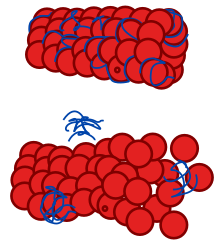Tauopati
| Tauopati Klassifikation | |
|---|---|
 | |
| Information | |
| Navn | Tauopati |
| Medicinsk fagområde | neuromedicin |
| MeSH | D024801 |
| Information med symbolet | |

Tauopati tilhører en klasse af neurodegenerative sygdomme associeret med den patologiske aggregering af tau-protein i neurofibrillære elle gliofibrillære knuder[1] i den menneskelige hjerne. Knuderne dannes af hyperfosforylering af et mikrotubuli-associeret protein kendt som tau, hvilket får det til at aggregerer i en uopløselig form. (Disse aggregationer af hyperfosforyleret tau-protein kaldes også paired heliske filamenter). Den præcise mekanisme hvorved knuderne formes kendes ikke præcist, og det er stadig kontroversielt om knuderne er primære kausale faktor i sygdommen eller spiller en mere perifer rolle. Primære tauopatier, altså lidelser hvor neurofibrillære knuder (NFT) primært observeres, inkluderer:
- Primær aldersrelateret tauopati (PART)/Neurofibrillære knude-primært senil demens, med NFT'er lignende AD, men uden plakker.[2]
- Kronisk traumatisk encefalopati,[5] herunder dementia pugilistica[6]
- Progressiv supranuklear parese[7]
- Cortikobasal degeneration
- Frontotemporal dementia og parkinsonism forbundet til chromosom 17[8]
- Lytico-Bodig syge[9]
- Ganglioglioma og gangliocytoma[10]
- Meningioangiomatosis[11]
- Postencefalitisk parkinsonisme
- Subakut skleroserende panencefalit[12]
- Såvel som bly encefalopati, tuberøs sklerose, Hallervorden-Spatz syge, and lipofuscinose[13]
Referencer
- ^ Rizzo, G.; Martinelli, P.; Manners, D.; Scaglione, C.; Tonon, C.; Cortelli, P.; Malucelli, E.; Capellari, S.; et al. (2008). "Diffusion-weighted brain imaging study of patients with clinical diagnosis of corticobasal degeneration, progressive supranuclear palsy and Parkinson's disease". Brain. 131 (Pt 10): 2690-700. doi:10.1093/brain/awn195. PMID 18819991.
- ^ Dickson, DW (2009). "Neuropathology of Non-Alzheimer Degenerative Disorders". International Journal of Clinical and Experimental Pathology. 3 (1): 1-23. PMC 2776269. PMID 19918325.
- ^ Santa-Maria, Ismael; Haggiagi A; Liu X; Wasserscheid J; Nelson PT; Dewar K; Clark LN; Crary JF (november 2012). "The MAPT H1 haplotype is associated with tangle-predominant dementia". Acta Neuropathologica. 124 (5): 693-704. doi:10.1007/s00401-012-1017-1. PMC 3608475. PMID 22802095.
- ^ Jellinger, K. A.; Attems, J. (2006). "Neurofibrillary tangle-predominant dementia: comparison with classical Alzheimer disease". Acta Neuropathologica. 113 (2): 107-17. doi:10.1007/s00401-006-0156-7. PMID 17089134.
- ^ Mckee, Ann C.; Cairns, Nigel J. (2016). "The first NINDS/NIBIB consensus meeting to define neuropathological criteria for the diagnosis of chronic traumatic encephalopathy". Acta Neuropathologica. 131 (1): 75-86. doi:10.1007/s00401-015-1515-z. PMC 4698281. PMID 26667418.
- ^ Roberts, GW (1988). "Immunocytochemistry of neurofibrillary tangles in dementia pugilistica and Alzheimer's disease: evidence for common genesis". Lancet. 2 (8626-8627): 1456-58. doi:10.1016/S0140-6736(88)90934-8. PMID 2904573.
- ^ Williams, David R; Lees, Andrew J (2009). "Progressive supranuclear palsy: clinicopathological concepts and diagnostic challenges". The Lancet Neurology. 8 (3): 270-9. doi:10.1016/S1474-4422(09)70042-0. PMID 19233037.
- ^ Selkoe, Dennis J.; Podlisny, Marcia B. (2002). "Deciphering the genetic basis of Alzheimer's disease". Annual Review of Genomics and Human Genetics. 3: 67-99. doi:10.1146/annurev.genom.3.022502.103022. PMID 12142353.
- ^ Hof, P. R.; Nimchinsky, E. A.; Buée-Scherrer, V.; Buée, L.; Nasrallah, J.; Hottinger, A. F.; Purohit, D. P.; Loerzel, A. J.; et al. (1994). "Amyotrophic lateral sclerosis/parkinsonism-dementia complex of Guam: quantitative neuropathology, immunohistochemical analysis of neuronal vulnerability, and comparison with related neurodegenerative disorders". Acta Neuropathologica. 88 (5): 397-404. doi:10.1007/BF00389490. PMID 7847067.
- ^ Brat, Daniel J.; Gearing, Marla; Goldthwaite, Patricia T.; Wainer, Bruce H.; Burger, Peter C. (2001). "Tau-associated neuropathology in ganglion cell tumours increases with patient age but appears unrelated to ApoE genotype". Neuropathology and Applied Neurobiology. 27 (3): 197-205. doi:10.1046/j.1365-2990.2001.00311.x. PMID 11489139.
- ^ Halper, J; Scheithauer, BW; Okazaki, H; Laws Jr, ER (1986). "Meningio-angiomatosis: a report of six cases with special reference to the occurrence of neurofibrillary tangles". Journal of neuropathology and experimental neurology. 45 (4): 426-46. doi:10.1097/00005072-198607000-00005. PMID 3088216.
- ^ Paula-Barbosa, M. M.; Brito, R.; Silva, C. A.; Faria, R.; Cruz, C. (1979). "Neurofibrillary changes in the cerebral cortex of a patient with subacute sclerosing panencephalitis (SSPE)". Acta Neuropathologica. 48 (2): 157-60. doi:10.1007/BF00691159. PMID 506699.
- ^ Wisniewski, Krystyna; Jervis, George A.; Moretz, Roger C.; Wisniewski, Henryk M. (1979). "Alzheimer neurofibrillary tangles in diseases other than senile and presenile dementia". Annals of Neurology. 5 (3): 288-94. doi:10.1002/ana.410050311. PMID 156000.
Medier brugt på denne side
Forfatter/Opretter: Resident Mario (talk) 17:27, 9 January 2012 (UTC), Licens: CC BY-SA 3.0
Tau proteins provide structural support for neural microtubules (Figure 1). Tauopathy is when they clump to one another instead of to the neuron structure (Figure 2), causing it to degenerate; this is one of the major symptoms of neural degenerative disorders such as Alzheimer's disease.
